Symptoms of rotavirus infection. Rotavirus infection
Rotavirus infection is a fairly common disease that people suffer from. different ages and gender. However, most often the disease occurs among children aged from 6 months to three years. They are usually affected by rotavirus. Immunity remains after each infection, so all subsequent attacks on the body are more easily tolerated. Symptomatology becomes less pronounced clinically, and adults get sick much less often.
You can get sick very often, because the pathogen has many strains. At the same time, most adults form antibodies because they have previously repeatedly transferred rotavirus infections. A very large percentage of antibodies to RVI is found in children. adolescence. However, many strains do not allow the immune system to cope with the pathology itself, with the result that the body is not completely protected from infections, although they proceed much easier.
Any infection reduces the immune system, so it needs some time to recover. Children may suffer from rotavirus infection repeatedly. In this case, it is difficult to establish the exact number of diseases, since very often they occur without visible symptoms.
Until recently, there was the practice of grafting rotavirus infection infants. However, it was later stopped, as medical studies confirmed the fact of intestinal obstruction after vaccinations. Currently, doctors have developed new, safer vaccines against infection.
Why do children get rotavirus
It is noticed that rotavirus infection most often affects the cold season. The disease is most common among children under the age of 3 years. This is because the infection in most cases is transmitted through household and through food.
Rotavirus affects absolutely all children, regardless of their living conditions, social and material status. General morbidity statistics in all countries among children under 3 years of age are about the same. At the same time, the mortality rate is very different. So, in less developed countries it is much higher.
Immunity to rotavirus has been developed for years, which explains the high incidence rate among children.
The fact is that the mother's antibodies protect the child only up to 12 months. After the extra protection ceases to function, children have an immature immune system, which is still too weak to resist the virus. Immunity is developed only after several transferred diseases caused by different strains.
How to improve immunity
There are several ways to strengthen the immune system to fight against rotavirus infection. Doctors usually prescribe Grippferon, Interferon or immunoglobulins, as well as vitamin complexes that have a beneficial effect on the human immune system, strengthening and “hardening” it. Most often these are drugs of plant origin. They are building a strong "wall" to protect against all sorts of infections, including RVI.
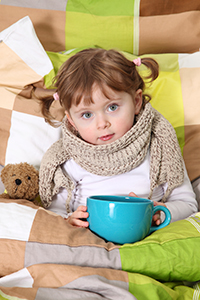
A great role is played by the right lifestyle. Initially, it is necessary to adjust the nutrition system (to exclude all junk food from the diet), to take the habit of exercise, to ensure a good rest for the child. In addition, it is necessary to reduce all stresses to a minimum.
It is necessary to take immunostimulants and other similar drugs as prevention only with the permission of the attending physician. Particular vigilance in such a situation should be exercised in relation to children. The child’s immune system develops only over the years and ends its formation only in adolescence.
Modes of transmission and symptoms of rotavirus infection
As already mentioned, the disease in most cases is transmitted through household contact and through contaminated food. Dairy products have their own characteristics of production, and therefore increases the risk of transmission of infection and through them.
One-year-old children most often begin to fall ill during a visit to the nursery, older ones - school and preschool institutions. Predominantly infection occurs through contact-household. At the same time, some strains of the virus provoke inflammatory processes in the respiratory tract, and therefore can be transmitted by airborne droplets.
The main and most common symptoms of infection include the following:
- headache and dizziness;
- feeling nauseous, often vomiting;
- temperature changes;
- runny nose, cough, sore throat.
Further, the infection penetrates deeper and stabs digestive system. Here is the most favorable environment for the reproduction of the virus. It spreads very quickly and affects the mucous membrane, which negatively affects the digestive function.
For this type of virus, it is characteristic that its particles do not penetrate into the blood. However, if it enters the intestine, the infection causes severe intoxication. The patient suffers from frequent bouts of nausea, he is tormented by vomiting and diarrhea.
In children, the symptoms of infection acquire a brighter clinical picture. So, immediately 3-5 days after infection or earlier baby begins to complain of high body temperature, bouts of vomiting, nausea, and not only after eating, but also on an empty stomach. Gradually, the little patient refuses to eat, because his appetite is gone, the cough begins, and the feces take on a gray or yellowish tint. The disease also affects the psycho-emotional state. The child does not want to do anything, he becomes very irritable, he is very naughty.
Conclusion
Immunity to rotavirus infection is developed over the years and the immune system is strengthened only due to a few past diseases. There is no universal drug for all strains.
A visit to the doctor when symptoms appear, resembling a rotavirus infection, is mandatory. An experienced specialist quickly recognizes a virus, the symptoms of which very much resemble the common cold. A timely diagnosis will provide an opportunity to localize the disease and prevent the spread of the virus in the system of the gastrointestinal tract.
It is possible and necessary to strengthen the immunity to this infection. Usually, medical preparations and vitamin complexes, which are prescribed exclusively by a doctor, are suitable for these purposes. In addition, we should not forget about the right lifestyle: a healthy diet, good rest, moderate but regular physical exertion.
And with doctors, and especially with patients, rotavirus infections often have discrepancies. Which group of diseases to include is a question that is not clear to the majority of ill people.
Viruses, flu, diarrhea
So common that probably there is no person who has never met with the infection. Rotavirus infections are mostly children (from 6 months to 5 years), although adults may also become infected. The most susceptible to infection are people from the foci of infection, as well as having problems with the immune system (pregnant, elderly, often sick with SARS, etc.). Due to the fact that rotavirus spreads "through dirty hands", household items and airborne droplets, the infection was called "gastric" or "intestinal" flu. In fact, rotavirus infection has nothing to do with flu. The virus’s favorite place of residence in the human body is the small intestine, but it can also attach to the cells of the upper respiratory tract. The latter causes the transmission of the virus when talking and sneezing and such symptoms of rotavirus infectionas a "red throat." The leading symptoms will always be gastrointestinal disorders.
By the way, the name of the virus comes not from the word “mouth”, as many believe, but from the word “company” - the wheel, since The virus itself is shaped like a wheel with a clear rim.
When have rotavirus infection
Rotavirus is resistant to many antiseptics and loves the cold very much, incl. and refrigerator conditions. That is why the disease is observed in the winter season. The infection spreads through sick people, and since Since the virus is highly contagious, it often causes outbreaks of the disease in organized groups, such as kindergartens, schools, dormitories. Often found intra-family transmission of the virus. The period from the moment of penetration of the rotavirus to the onset of the first symptoms ranges from 15 hours to 5-7 days.
How does the disease flow
Symptoms of rotavirus infection begin acutely with a sharp deterioration, anxiety, weakness, refusal to eat, pain in the abdomen. During the first day, the entire clinic, which is characteristic of rotavirus infection, develops. Vomiting at the beginning of the food eaten, then with water with mucus and bile up to 10-15 times a day. The diarrhea begins next, and the stool is abundant, watery, frothy, almost odorless, up to 20-25 times a day. The urge to stool is sharp, painful, with a rumbling in the stomach. The acute period of 2-3 days is accompanied by fever, which can reach high figures of 39-40 grams. Celsius
Dangerous symptoms of rotavirus infection- dehydration, which may occur as early as the first day of the disease due to loss of fluid and salt with vomiting and diarrhea. Another danger is the exacerbation of chronic gastrointestinal diseases, the development of intestinal dysbiosis.
Treatment of rotavirus infection
Symptoms of rotavirus infection require emergency room. Primarily for the prevention of dehydration. Dispense the patient should be carefully, but carefully. A single volume of the resulting fluid - from 1 teaspoon. It is better to give the drink fractionally and in small portions, then the probability of loss of the resulting liquid is minimal. For oral rehydration, aimed at filling the loss of fluid and salt through the mouth, use ready-made pharmaceutical solutions (rehydron, enterodez, ORS 200). If it is impossible to vypoit, the patient is hospitalized for infusion therapy. Also used in the treatment of symptomatic means - antiemetic, sorbents, enzymes (from the second day of illness). In the treatment of rotavirus infection, a diet restricting milk and dairy products is mandatory.
Features of immunity with rotavirus infection
 First of all, rotavirus has several varieties, which means you can get sick often. Immunity to rotavirus is type-specific, subsequent infection with the same type of virus is easier. Healthy adults have a more acidic environment of the stomach and enough local protection factors, which allows them to “not get sick” with rotavirus. Although in reality, it is possible asymptomatic rotavirus infection or carrier of the virus. Such adults are dangerous to others, because can be a source of infection. Children are sick more often, because have an immature immune system that is not able to immediately react to the penetration of the virus. That is why the use of immunomodulating and antiviral drugs, such as interferon or specific immunoglobulins, has been shown in the treatment of children, as well as patients with weakened immunity. Among the latter the most popular are the anti-rotavirus immunoglobulin and the complex immunoglobulin preparation. Among interferons, local doctors prefer the drug ® based on alpha-2b-interferon, enriched with vitamins C and E. The high antiviral activity of the drug is associated in particular with the ability of antioxidant vitamins to change the membranes of the surrounding cells and prevent their infection. In addition, VIFERON® has an immunomodulatory effect in the focus of inflammation, accelerates the production of specific antibodies.
First of all, rotavirus has several varieties, which means you can get sick often. Immunity to rotavirus is type-specific, subsequent infection with the same type of virus is easier. Healthy adults have a more acidic environment of the stomach and enough local protection factors, which allows them to “not get sick” with rotavirus. Although in reality, it is possible asymptomatic rotavirus infection or carrier of the virus. Such adults are dangerous to others, because can be a source of infection. Children are sick more often, because have an immature immune system that is not able to immediately react to the penetration of the virus. That is why the use of immunomodulating and antiviral drugs, such as interferon or specific immunoglobulins, has been shown in the treatment of children, as well as patients with weakened immunity. Among the latter the most popular are the anti-rotavirus immunoglobulin and the complex immunoglobulin preparation. Among interferons, local doctors prefer the drug ® based on alpha-2b-interferon, enriched with vitamins C and E. The high antiviral activity of the drug is associated in particular with the ability of antioxidant vitamins to change the membranes of the surrounding cells and prevent their infection. In addition, VIFERON® has an immunomodulatory effect in the focus of inflammation, accelerates the production of specific antibodies.
Prevention of rotavirus infection
Primarily aimed at the elimination of transmission routes. Nonspecific prophylaxis includes hand washing, heat treatment of milk, water and other food products, compliance with sanitary standards of water supply, sewage systems, in children's institutions, on food storage, etc. Specific prophylaxis with the use of the vaccine can reduce the mortality from diarrhea in children during the first 2 years of life, especially in socially disadvantaged regions.
Based on:
"Viferon: modern opportunities in the prevention of influenza and other acute respiratory viral infections in children who are often ill." T.A. Chebotareva, V.V. Malinovskaya, L.N. Mazankova, S.K. Karyaeva, O.V. Parshina, TS Guseva, V.V. Lazarev, Z.D. Kaloev.
is an infectious diseasecaused by the virus "Rotavirus", which belongs to the order of the rotavirus (lat. Rotavirus). Rotavirus in humans passes incubation period for two, maximum five days. Rotavirus infection affects adults and children, but children are more difficult to tolerate; in adults, rotavirus is easier. The patient is contagious from the first day of infection until the very last day of infection, that is, after a week of treatment; usually a week is enough for a person to recover. After the body develops immunity to rotavirus, it is extremely difficult to re-infect them. In children, adults with low levels of antibodies, the disease may recur.
Transmission of rotavirus infection
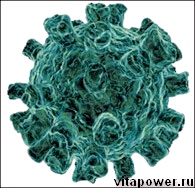 can be transmitted through unwashed vegetables, fruits, through the dirt on their hands, through infected food. Rotavirus infection can live at 0 degrees, bleach does not kill rotavirus. In children, rotavirus infection may result from a visit. kindergarten, schools, as it is a place where many people work and study. Rotavirus is often infected with airborne droplets through a sneeze.
can be transmitted through unwashed vegetables, fruits, through the dirt on their hands, through infected food. Rotavirus infection can live at 0 degrees, bleach does not kill rotavirus. In children, rotavirus infection may result from a visit. kindergarten, schools, as it is a place where many people work and study. Rotavirus is often infected with airborne droplets through a sneeze.
It manifests itself as episodic cases of the disease, epidemics. Epidemics occur during the cold season (from November to April). Rotavirus penetrates into gastrointestinal tractcauses inflammation of the intestinal mucosa.
Rotavirus infection in children
In children, it proceeds secretly at first (incubation period of up to 5 days), followed by an acute period (up to a week, if there are complications, then two weeks), recovery from an illness (about a week).
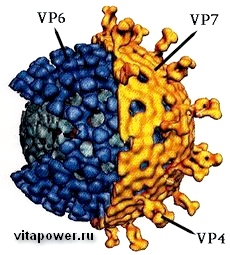 Rotavirus is manifested by vomiting, a sharp rise in temperature to 38-39 degrees, diarrhea appears, fluid stools, changes color from yellow to gray and dark gray. manifested by runny nose, redness in the throat, inflammation of the tonsils. In the acute period, patients are lying, they do not want to move, there is a state of fatigue. Rotavirus accompanies influenza epidemics, rotavirus is easily confused with hepatitis, there is often light feces, urine darkens, blood appears in the urine, signs of hematuria.
Rotavirus is manifested by vomiting, a sharp rise in temperature to 38-39 degrees, diarrhea appears, fluid stools, changes color from yellow to gray and dark gray. manifested by runny nose, redness in the throat, inflammation of the tonsils. In the acute period, patients are lying, they do not want to move, there is a state of fatigue. Rotavirus accompanies influenza epidemics, rotavirus is easily confused with hepatitis, there is often light feces, urine darkens, blood appears in the urine, signs of hematuria.
Guys in the hot period rotavirus infection they become capricious, they feel sick in the morning, vomits on an empty stomach, vomits with mucus. Appetite may not be, vomiting after eating and drinking (more than 100 ml of liquid). The temperature is high, in the evening it rises to 39 degrees; fever lasts about 5 days. In case of a rotovirus infection, the kids are popping with liquid feces with a very repulsive odor, the stomach hurts, twists, swelling occurs. The child begins to lose weight, he wants to sleep constantly. With timely and proper treatment rotavirus passes within a week, there is a full recovery.
In different children it proceeds with varying degrees of intensity: someone may be confused with poisoning, cholera, salmonella. If a child's temperature rises, he becomes sick, goes to the toilet with liquid feces, then a doctor should be called to the house from the children's hospital. If the stomach hurts unbearably, then you need to call an ambulance.
Rotavirus infection in adults
Adults are also susceptible to rotavirus, but often take symptoms as a digestive upset. Nausea and vomiting not diagnosed weakness, loss of appetite, a slight increase in temperature, liquid feces. in adults it is difficult to identify, often there are no symptoms, but the patient remains infectious, although they have stronger immunity compared with the kids, the gastrointestinal tract is more adapted to this kind of testing. If one member of the family gets sick, then in five days the whole family is sick, only a strong immune system will save from rotavirus infection.
Treatment of rotavirus infection in a child
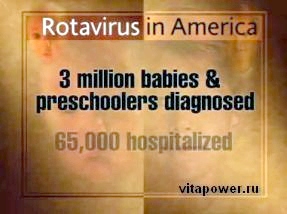 Rotavirus infection is difficult to kill, remove symptoms, normalize water-salt balance, prevent the development of secondary infection. The goal of treating rotavirus infection in children is to combat the effects of rotavirus on a child’s body: cardiovascular and urinary system disorders.
Rotavirus infection is difficult to kill, remove symptoms, normalize water-salt balance, prevent the development of secondary infection. The goal of treating rotavirus infection in children is to combat the effects of rotavirus on a child’s body: cardiovascular and urinary system disorders.
When a child has signs of rotavirus, dairy products should be abandoned, since kefir is an excellent medium for the growth and reproduction of bacteria.
You should not rape the child and force him to eat, even though you feel sorry for him, although he does not eat much and often, it is better to drink him with jelly (made from water, starch, jam), you can also drink chicken broth. If the appetite is not greatly reduced, it is allowed to feed the child rice porridge on the water without oil. Eat and drink in small sips, in order to prevent the vomiting reflex.
In the treatment rotavirus infection prescribe activated carbon, smectite, attapulgit. If the child vomits violently, then it loses a lot of water, so you need to fill up the volume of liquid. To do this, one packet of rehydron should be dissolved in a liter of water and the child drinks 50 ml every 30 minutes until everything is drunk. If the child sleeps, skips drinking, then you should not wake him up, you must wait until he wakes up, but you cannot give more than 100 ml at a time;
How to reduce the temperature during rotovirus infection
Not able to survive at temperatures above 38 degrees, below 38 degrees should not bring down the temperature. Children should be prescribed ceferon suppositories, paracetamol only for children over 3 years of age (the dosage should be observed). Candles can be put at bedtime. If the temperature does not go astray, children older than one year are usually prescribed paracetamol with a quarter of analgin. If tablets and suppositories contain paracetamol, then the break should be at least 2 hours. Paracetamol for rotavirus infection is most effective.
Well wipes the temperature wet wiping a weak vodka solution, but you should follow some rules: you should wipe the entire body of the child, after wiping wear thin socks on the legs.
In case of abdominal pain with susceptible diagnosis of rotavirus, doctors usually give the child a cushion: 1 ml of no-shpa solution from the ampoule should be given to the child in the mouth, taken with tea.
Complications of rotavirus infection
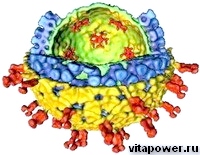 If you pass the treatment rotavirus infectionthen it proceeds without complications. A child with a rotavirus infection should be watered often, as dehydration can lead to death. It is necessary to take measures in order to prevent the accession of bacterial intestinal infection. Be sure to monitor the temperature, if it is above 39 degrees, then this leads to cell death.
If you pass the treatment rotavirus infectionthen it proceeds without complications. A child with a rotavirus infection should be watered often, as dehydration can lead to death. It is necessary to take measures in order to prevent the accession of bacterial intestinal infection. Be sure to monitor the temperature, if it is above 39 degrees, then this leads to cell death.
Fatalities are observed in 2 percent of the diseases, mainly in children with weak immunity; after recovery, there are no long-term health effects.
Prevention of rotavirus infection
For prophylaxis rotavirus infection It is necessary to get vaccinated, at the moment there are two vaccines, both must be taken orally, contain a weakened live virus. Rotavirus infections are currently available abroad.
Nonspecific prophylaxis is also distinguished, which is in compliance with sanitary and hygienic standards, that is, washing hands with soap, using filtered and boiled water.
Rotavirus infection (RVI) can occur, as easily and imperceptibly, and very hard. It often begins with sore throat, cough and runny nose, and then vomiting, plentiful watery stools and heat. So what could lead to severe rvi?
Immediate danger from rotovirus infection
The most important danger when severe course Rotavirus infection is dehydration (eksikoz), caused by repeated vomiting and loose stools. Especially hard to tolerate dehydration are young children, who against this background may begin seizures, various disorders of the cardiovascular system and kidneys. The kidneys react very hard to dehydration and intoxication, they simply stop their work and toxic substances are not removed from the body. This condition is called acute renal failure, which is very difficult to treat, even in resuscitation.
Parents should not give up referral to the hospital if, against the background of vomiting and diarrhea, the child has pronounced dryness of the skin and mucous membranes (this is especially evident from chapped lips) and has not been urinating for several hours. To help such a child to restore the water-salt metabolism can only intravenous drip of special solutions. Otherwise, the condition can deteriorate very quickly and the child can be lost. According to literary data in the United States, over one million children ages one to four years old get rotavirus infection every year, of which up to 150 children die. At the same time, timely admission of the child to the hospital is a guarantee of his recovery.
Long-term effects
A feature of the action of rotavirus on the gastrointestinal tract is that it can cause a persistent violation of the digestion and absorption of food and a decrease in the secretion of intestinal enzymes. All this leads to the fact that the acidity of the contents of the intestine changes, it acquires an alkaline reaction, in which conditionally pathogenic and pathogenic microflora feels more comfortable, it begins to actively reproduce. The beneficial microflora, which normally suppresses the development of conditionally pathogenic, in this case, on the contrary, has difficulty in reproduction, since the acidic environment is more common for it.
Violation of the ratio between beneficial and opportunistic microflora is called dysbacteriosis. Dysbacteriosis is not yet a disease, opportunistic microorganisms are still multiplying in the intestinal lumen, disrupting the digestive process, but they still do not penetrate the intestinal wall mucosa. But digestive disorders (without the normal volume of beneficial microflora, it cannot occur correctly) already cause circulatory disorders (and therefore metabolism) in the intestinal wall and only one step remains before the formation inflammatory processthat is, colitis.
Dysbacteriosis in a child may manifest as a decrease in appetite, constant bloating due to large amounts of gases (due to improper digestion of food), paroxysmal pain along the intestines (they occur due to spasm of the muscles of the intestines), nausea and impaired stool. Alternation of diarrhea is characteristic of dysbacteriosis (the stool may have a fetid odor) and constipation when feces take on the appearance of hard pellets (sheep feces).
Dysbacteriosis requires long-term persistent treatment. Probiotics are prescribed - medications, which contain colonies of living beneficial bacteria - the natural inhabitants of the intestines. In order for these bacteria to settle down well in the intestines and multiply rapidly, prebiotics are prescribed - drugs that contain “feed” for beneficial microflora.
How does immunity change after rotavirus infection?
As after any infection, the overall immunity is reduced and time and effort are required to restore it. Specific immunity to rotavirus infection is not very persistent, so a child may have RVI on many occasions, and it is difficult to determine exactly how much, because RVI is often asymptomatic. Adults most of them have antibodies to rotaviruses in their blood, which also means that the infection was transferred more than once. A very high percentage of detection of antibodies to rotavirus and in children of older age groups.
Several years ago, in the United States, children had been inoculated with rotavirus vaccine for a month and a half, but then it was found that this leads to an increase in the frequency of intestinal obstruction in children, and the use of the vaccine was prohibited. Today, new vaccines for RVI are being developed (including in our country), which are already at the stage of clinical trials. Rvi like most viral infections, is currently not completely defeated.
Popular
- What is useful mineral water
- What is the name of the Scottish skirt
- What women like a man archer
- Dosage and use of doxycycline when tick bite
- Sinupret - complete instructions
- Number of antennae in arachnid and insect crustaceans
- Help for enterobiasis for the pool, how much is valid
- Ceftriaxone suspension. What is ceftriaxone?
- Third degree breast cancer: prognosis and treatment
- Salt Scrub for the scalp




